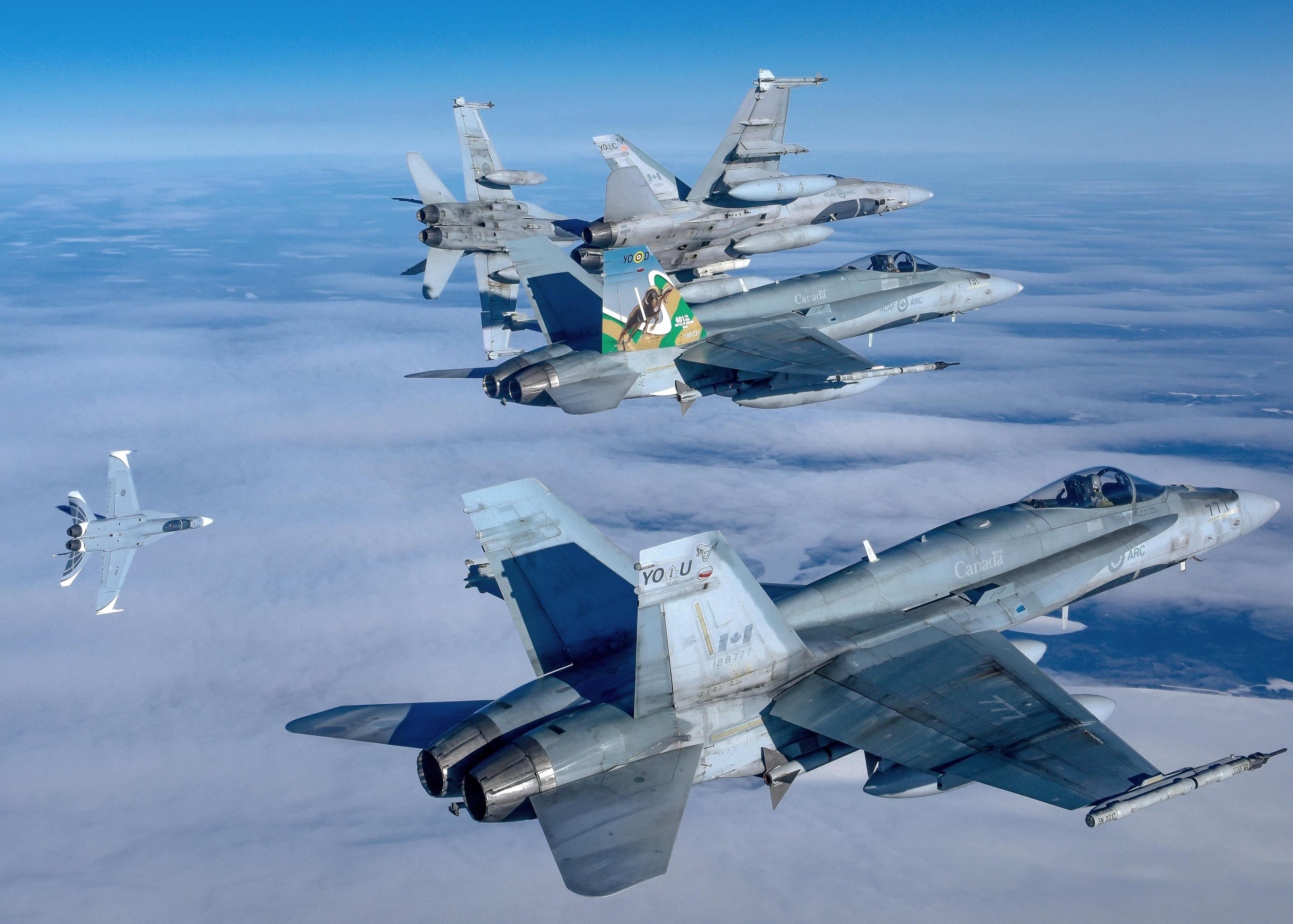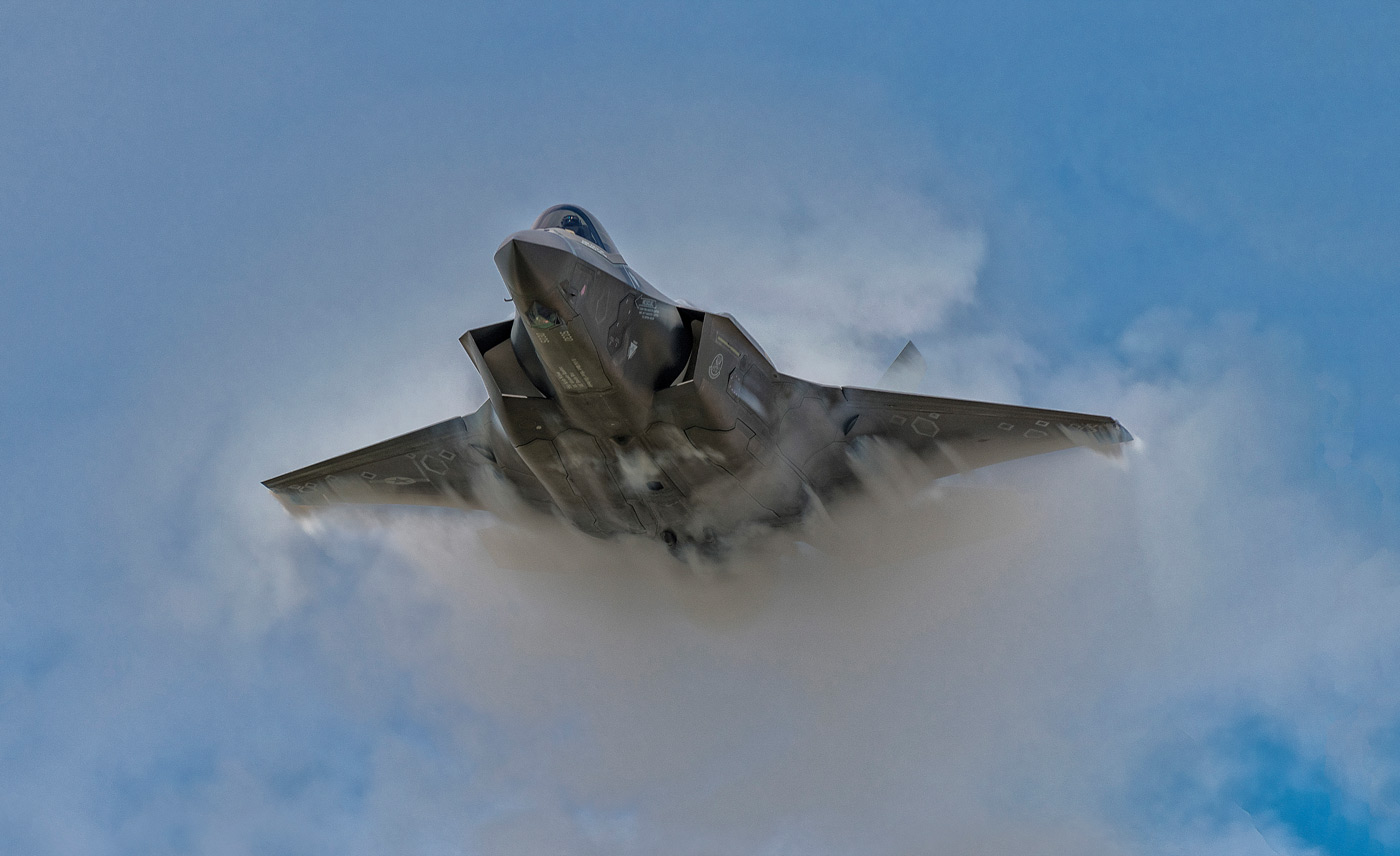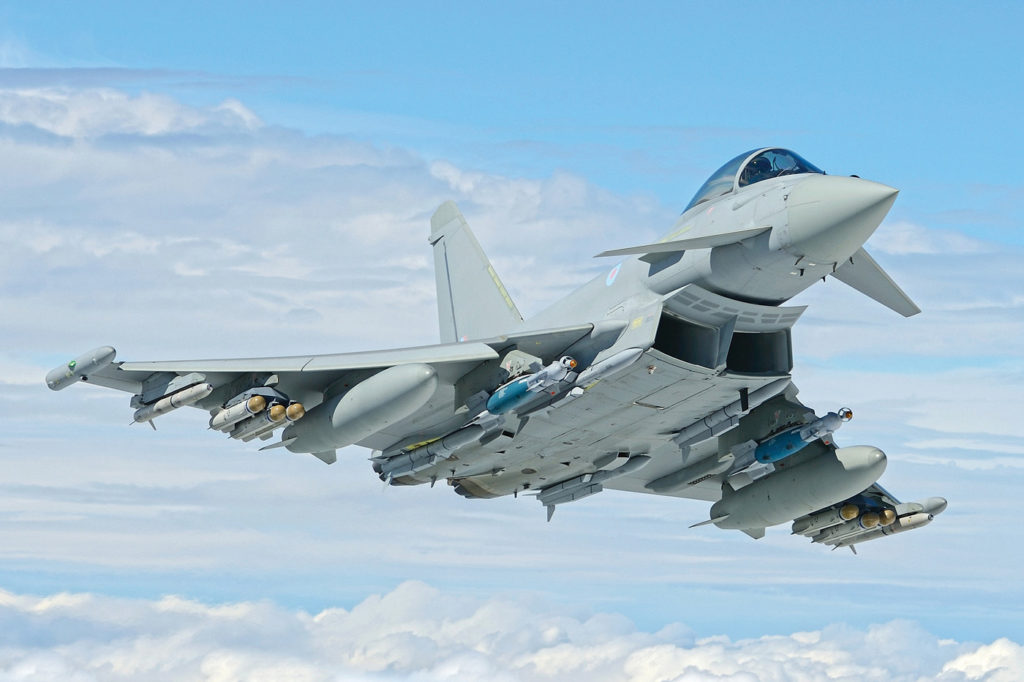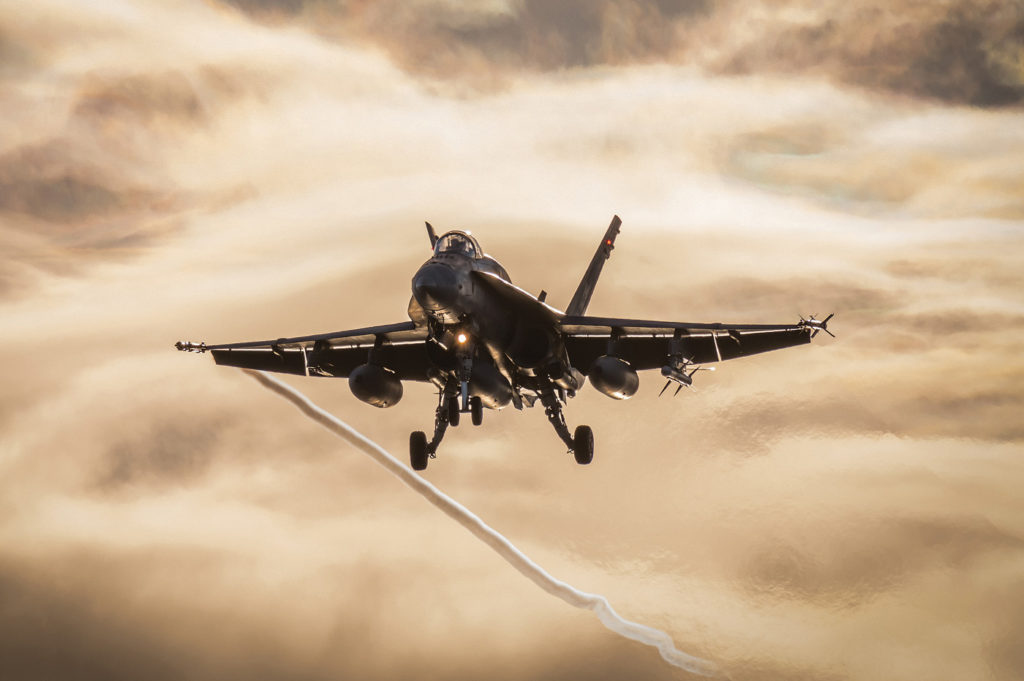Estimated reading time 16 minutes, 52 seconds.
This article originally appeared in the 2019 edition of RCAF Today magazine.
Purchasing a fleet of fighter aircraft is a complex process with many variables and the Canadian government has a duty to ensure the billions of procurement dollars are properly spent. The interplay between the four dimensions involved in military procurement — military, technological, economic, and political — defies simple analysis.

Unfortunately, the politicization of the CF-188 replacement has led to significant misinformation and distortion of the factors surrounding this essential capital procurement. Conflation of idiosyncratic design features, such as stealth and one versus two engines, into critical determinates undermines public understanding of the four dimensions that constitute military procurement decision-making.
The 2017 defence policy, Strong, Secure, Engaged (SSE), directed the Canadian Armed Forces (CAF) to ensure Canadian sovereignty, defend North America, and engage in extraterritorial missions. The Royal Canadian Air Force (RCAF) responded to its responsibilities to support these commitments with a thorough, capability-based Statement of Requirements (SOR) for the Future Fighter Capability Project (FFCP), taking critical functionalities of operating in the future battlespace and emerging technologies into consideration. The SOR was prepared using a professional, evidence-based US Defense Acquisition Test and Evaluation Management framework to ensure it met the rigorous standard the Auditor General of Canada’s 2012 Spring Report said the previous CF-18 replacement documentation lacked.

Cleavages
Four pre-qualified suppliers are expected to submit bids: Lockheed Martin (F-35 F-35 Lightning II), Boeing (F/A-18 Super Hornet), Saab (Gripen E), and Airbus (Eurofighter Typhoon). Their fighters represent two significant groupings or cleavages. The first is technological/sustainability, namely between fourth- and fifth-generation fighter aircraft and revolves around long-term sustainment costs and future technological adaptability.
The second is commercial/security, specifically European (Eurofighter/Gripen) versus American (F-35/Super Hornet) and enmeshes national security compliance with the government’s desire for tailorable economic packages. The specificity of these cleavages is important to understand as they have repercussions in each of the four decision-making dimensions.
Although there has been much debate regarding the definition of fifth-generation fighters, the distinction between fourth- and fifth-generation fighters rests in the design concepts. Adapting to evolving technologies, fifth-generation fighters are purpose-built low-observable designs to enhance survivability against increasingly lethal defensive missile systems. Fourth-generation fighters are based on proven 1970/80 platform designs that have been updated with contemporary avionics and sensors, but are highly vulnerable to modern air defence systems. Fourth-generation aircraft have very limited growth potential in their architecture and long-term sustainability is questionable.
The European versus American cleavage revolves around the emphasis that the government places between security and economic interests. These often-competing issues transcend all four dimensions as national security issues intersect both the desire for political economic largesse and commercial/U.S. national security concerns, which can result in modification of military/technological requirements through political interventions.
Operating Environment
Canada’s geostrategic position and alliance commitments constrain the choices that are available. Canadians need to understand that the international security environment directly shapes the North American strategic defence posture and that NORAD is central to that defence. This makes airspace defence an issue of ‘complex sovereignty’ as NORAD functions both as guarantor of Canadian, as well as American, airspace sovereignty and is the principal defender of North America from air attack. Canada’s next fighter aircraft will need to be factored into the future multi-domain battlespace that is being constructed by the United States, and not simply through the notional threat-to-Canada environment of the moment.

Geostrategically, the U.S. employs a three-layer approach to its national security. Protection of the ‘homeland’ is the first layer and is paramount. As such, the U.S. is obsessive in its commitment to safeguarding its military and technological advantages, first judiciously sharing with Two Eyes partners, then Five Eyes countries, then other allies, if at all.
Although critical to the protection of the homeland, Canada occupies the second layer of U.S. defences — the approaches — and shares a deeply held responsibility to which the U.S. entrusts some its most technically advanced capabilities through Two Eyes bilateral protocols. To maximize effectiveness, any future fighter must be fully integral to the future North American battlespace, as opposed to simply being integrated and interoperable as is the accepted practice in NATO.
Military Dimension
In its primary role, the fighter force acts as a strategic deterrent to those that may wish to challenge Canada’s sovereignty. By design, these fighter aircraft are essential in the binational NORAD command and control (C2) structure. This makes the fighter force unique in that they are the only Canadian military force that is operationally interdependent with the U.S. in day-to-day operations. It is therefore extremely difficult to delink air superiority operations in the first two principal CAF roles identified in SSE, Canadian sovereignty and defence of North America, given the integrated infrastructure and binational C2 arrangements.

Although the four qualified supplier’s fighters will have met the basic high-level mandatory requirements to compete in the FFCP bid, the RCAF has identified sub-system requirements that will ensure they are fully able to operate in current and future battlespace environments. Without these sub-systems, operational risks increase to the point that a future fighter becomes marginally employable in domestic (NORAD) and/or expeditionary (NATO) operations. Each platform will be rigorously assessed through a Measure of Effectiveness and Evaluation scale in the context of an increasingly complex and contested threat environment for interoperability, ability to maintain awareness, capability to discern friend from foe, survivability, and sustainability.
Significantly, the U.S. has embarked on a multi-domain operations concept and the U.S. Air Force (USAF) is currently developing a “Multi-Domain Command and Control (MDC2) [system] — the ability to seamlessly analyze, fuse, and share what was once domain-centric information into a single C2 system that supports all domains and all levels of war.” The USAF has partnered with the U.S. Army to explore developmental avenues for Joint and NATO MDC2 integration. This represents the future operational command and control environment that the commander of U.S. NORTHCOM/NORAD will employ in defence of North America and is an acknowledged imperative in the RCAF Future Concept Directive.
The fighter chosen must be technologically advanced enough to be a strategic deterrent and not seen by the U.S. and potential adversaries as a weak link in NORAD. It must be an intrinsic element of the evolving C2 structure. Canada holds a unique and prestigious position in the only binational military command the U.S. has permitted.
Along with this enormous military responsibility, there is little doubt that the U.S. will hold Canada directly accountable for any breaches in the defence of North America that can be attributed to Canada minimizing its commitment to military preparedness. Moreover, Canada benefits greatly from enhanced air defence without paying the costs of establishing a complex, stand-alone Canadian C2 system.
Technological Dimension
Embracing leading edge technology to gain operational advantage has always been central to air forces worldwide. In most instances, short-term advancements in force development can be accommodated in modern platforms, but there are eventually generational changes that are structural in nature. A future fighter platform that requires a life expectancy past 2060 will need to be adaptable, flexible, and expandable beyond the known current trends.
Emerging technologies like artificial intelligence will change the dynamics of decision-making, not only in the platforms but in the C2 system as well. The cyber domain will be both an enabler and a threat as sophisticated systems become ever more reliant on computation and information networks. Space is becoming prevalent in all aspects of military operations. Importantly to Canada, the RCAF leverages U.S. space capabilities for remote northern operations and is the only ally on the system.

Gen David Goldfein, USAF Chief of Staff, sees a fifth-generation fighter as a computer that happens to fly and part of the connective tissue under the concept of multi-domain operations. The by-design fighter characteristics of sensor information fusion, advanced weaponry, increased survivability through low observability, and networked-enabled mission support are essential aspects of the next generation of fighter aircraft.
Although the multi-domain concept envisions an open architecture for allies to ‘plug and play,’ the American approach differs to that of some European nations who are developing sixth-generation fighters of their own while keeping fourth-generation aircraft long enough for the transition expected in the mid-2040s.
As there are significant commercial and national security interests in maintaining military and technological advantages by the U.S. government, fighter manufacturers, and equipment suppliers, there will inevitably be significant resistance to enabling non-American fighter aircraft access to advanced, sensitive technology should Canada choose a European model.
Canada may have to do without a desired system given Two Eyes/Five Eyes restrictions or will likely have to pay exorbitant amounts to have the equipment integrated into the Operational Flight Program (OFP) as access to intellectual property (IP) is highly contained.
However, the main question regarding purchase of fourth-generation fighters revolves around how long they can remain technologically relevant into the future advanced operational and threat environments without restrictions to their intended roles.
Economic Dimension
At $15 to $19 billion, the FFCP will be the second most expensive procurement in Canadian history. The government has a fiduciary responsibility to exercise due diligence in seeking the most cost-effective solution and the best-value for money. This concept, however, is complicated as various actors within the decision-making process have differing responsibilities with conflicting priorities that compete for short-term and long-term interests.
Therefore, the process of shaping the bid through mandatory requirements and weighting of evaluation criteria in the final request for proposals (RFP) becomes a significant tool in the determination of preferred outcomes. In the FFCP bid process, two issues of concern to an open and transparent competition have arisen.
The first involves the government’s determination to optimize competition through ensuring enough qualified bidders. In response to Dassault’s decision to withdraw from the bid process due to difficulties in meeting mandatory Two Eyes/Five Eyes requirements, the government stated it would evaluate bids in a different way and require non-compliant companies to identify a solution to meet the deficiencies.
This deferment effectively changes military requirements and opens the possibility of purchasing incompatible equipment that meet a lower threshold. It begs the question of how a foreign business entity can provide an acceptable solution that requires U.S. government approval from the Departments of State, Commerce, and Defense to sanction any inclusion of U.S. classified capability.

Secondly, the Canadian government has a long-standing policy to ensure defence dollars are reinvested into meaningful economic benefits. Offset obligations have become a favorite tool to meet socio-economic goals, however this approach can undermine the goal of acquiring the best military solution when development objectives become the political imperative. By indirect means, the government of the day can shape a military procurement to meet its short-term interests through Industrial and Technological Benefits (ITB) requirements.
In the case of the FFCP acquisition, the ITB requirement is problematic for a “fair and transparent” process, in part due to conflicts with agreements signed between Canada and the U.S. as part of Canada’s participation in the Joint Strike Fighter (JSF) program. The most recent changes to the draft RFP have been made to better balance the competition in recognition of Canada’s obligations as a member of the program; however, rivals have pushed back using ITB arguments to maintain competitive advantage. Without a transparent levelling of the ITB assessment criteria contained in the final RFP, the spectre of the Liberal government’s promise, “We will not buy the F-35 stealth fighter-bomber,” becomes a reality through other policy means.
Retention of the ITB requirement and preservation of a large bidder pool also stems from short-term parochial interests of the governing party. In an election year, the promise to assemble aircraft in Canada certainly provides work-related incentives, but one must question the long-term economic benefits and export potential of building fighters in a country that refuses to sell civilian helicopters to the Philippines.
Additionally, the offer of complete transfer of IP for non-American platforms is a double-edged sword. Without the benefit of a large pool of resources, the costs associated with developing and continually modifying the OFP, the embedded software that performs the functions and sub-functions necessary for aircraft weapon systems to operate, are huge. Getting the OFP wrong results in accidents such as the recent Ethiopian Airlines Boeing 737 Max crash. Attempting to integrate discordant equipment into unique platforms is difficult and imprecise. Modifying military requirements to meet short-term parochial socio-economic interests and benefits can entail unintended costs and consequences.
Furthermore, each fighter manufacturer has commercially sensitive IP that it protects vigorously. As two European groups have recently announced plans for the development of ‘sixth generation’ fighters, the U.S. will undoubtedly be far more protective of inadvertent transfer of advanced technologies to competitors, thus limiting the adaptability of non-American fighters for Canadian use.
The RCAF knows well the synergistic savings that accrue when operating a common fighter with Canada’s principal ally. Sustainment is the most costly, complex and challenging aspect of the lifecycle cost, making this element singularly important to the Department of National Defence. Most air forces are looking to divest themselves of fourth-generation fighters by 2040, nine years after FFCP is scheduled to achieve Full Operational Capability. Sustaining a diminishing or orphan fleet of aircraft until 2060 would be prohibitively expensive and operationally irrelevant.
Fifth-generation fighters are not without their procurement and sustainment problems; U.S. defence officials have questioned the initial capital costs and the affordability of maintaining the fleets. However, F-35 Joint Program Office (JPO) reports estimate the cost of Lot 14 F-35A aircraft will decrease to US$76.8 million, making the initial procurement comparable to or cheaper than some of its competitors.
Additionally, the JPO has been directed to focus on substantially improving sustainability. In October 2018, Belgium’s government chose the F-35 over the Eurofighter primarily on price and the savings benefits accrued over the 40-year life of the aircraft from a projected production pool of 3000 aircraft, defying the myth of the F-35 being an overpriced fighter.
Political Dimension
Politics is ubiquitous in issues of national security. Governments must determine Canada’s defence needs, articulate the way they are to be achieved, provide the means to meet the stated requirements, and sell these decisions to the electorate. Unfortunately, under Canada’s parliamentary system, the cycle of major Crown projects is progressively out of sync with the electoral cycle and political parties take short-term advantage of the procurement process.
Military needs, the basis for spending the money in the first place, have been obfuscated in the replacement process and significant political capital has been expended through bipartisan mismanagement. One must question the utility and fairness of a competition when the current government is on record making disparaging statements about both American products. SSE sets a very high standard for the fighter force to meet, but governments must stop manipulating the requirements and respect military advice for this to be achieved.
The U.S. is not only an ally, but a partner in NORAD, and it must wonder how reliable and trustworthy Canada truly is as it witnesses the dithering over an essential element of its shared defence structure. With negotiations on the replacement of the North Warning System imminent, Canada needs to consider American tolerance of continued lopsided cost-sharing arrangements. Without a greater strategic outlook on this procurement, Canada puts its reputation as a trusted neighbour, as well as the significant cost-savings it enjoys as an integral partner in defence of North America, at risk.
Since there are few votes to be had for defence issues, long-term geostrategic considerations have been minimalized by successive governments through competition in domestic politics. In an election year, there is great temptation for political interference in the procurement process for political advantage in the guise of regional benefits.
Granted, philosophical differences are in play between political parties that will affect how they view economic benefits to Canada. However, if this is a deterministic factor, then the government has an obligation to state this clearly. Otherwise, unwarranted political interference in shaping the process to favour a specific outcome has a deleterious effect on the professional women and men in the military and public service who see the political spin for what it really is, the self-interest of political parties.
Conclusion
The government’s choice to ensure a competitive process with more than three bidders has resulted in modifications to the assessment of mandatory criteria in critical operational functions, lowering the threshold of performance measurements identified by the RCAF. Suitability and adaptability to Two Eyes/Five Eyes requirements will be a crucial operational determinant. However, application of the current ITB policy and the points awarded for the economic offset portion in the RFP appears to undermine the primacy of meeting military needs.
Canada is a North American state with responsibility to protect not only ourselves but our most important strategic partner and neighbour. To maximize effectiveness, any future fighter will need to be fully integral to the North American battlespace. The deputy minister of National Defence has stated that capability is the core component in the procurement process. Allowing economic benefits to prevail over capability during evaluation inevitably changes the empirical equation of the stated government policy that initiated the purchase in the first place.
The choice of a future fighter is critical and should have bipartisan support since it now occurs every two generations. To put this into human terms, the first new pilots eligible to fly the next fighter will be graduating from high school this year. Those in kindergarten will have served 35 years in the RCAF by the time the next fighter is purchased.
When one reflects on the costs involved and the changes that will occur over the next 40 to 50 years, the government not only has a responsibility to deliver the best-value to Canadians for the roles it has instructed the military to perform, it also has a duty to ensure Canada’s future aviators have the best equipment to perform the hazardous duties they will be assigned. SSE promises this upfront. A fair and balanced competition for the future fighter, uninhibited by overt political interference, needs to occur to ensure the right fighter aircraft is chosen.
Alan Stephenson (Col ret’d) holds a PhD from Carleton University and is a former CF-188 pilot with 3600 hours flying fighters. He is currently an aviation consultant and a Fellow at the Canadian Global Affairs Institute.

With 30 years experience in the RCAF…CAF…Canadian Forces…Yes, all the same outfit believe it or not. I can be quite sure that after thousands/millions of dollars spent on the evaluation process of a new fighter, we will do what we have always done. We will buy the cheapest fighter available with no thought of future upgrades and few if any parts. The new fighters will be purchased by politicians who have no idea what is really required. The more things change the more they stay the same.
This Government or the next will most likely make the wrong decision either way as per usual, you only have to look at the Government pay system Phoenix to see how buerocrats can cock things up.
Ultimately we have to buy American I would think as we are so integrated into there military anyway and being there closest ally in the defence of North America.
The best choice of the American fighters would be the F35 VTOL as in the case of war we could hide them in our vast Northern areas like the Swedes do with there fighters though I don’t think the Grippen is VTOL but they can land on unimproved roads and be hidden and moved around at will making them less vulnerable to first strike attacks on airfields.
In none war settings regular airfields would surfice for everyday operations.
Get the coolest looking. Really, because (hopefully) you won’t even be using the damn things anyway— go with Gripen. Or better yet say screw it and buy Rafale’s. Or really blow minds and buy Su-35’s.